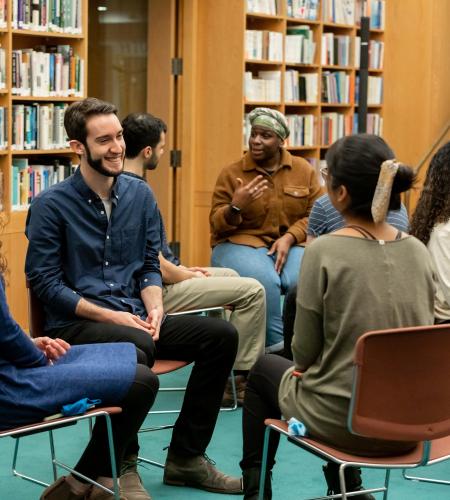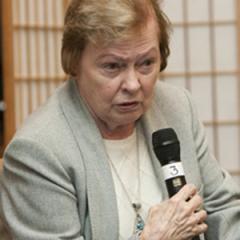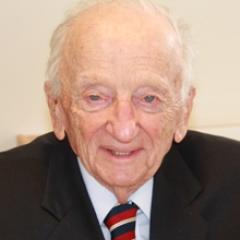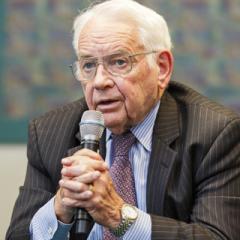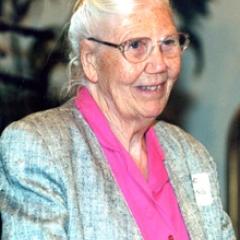In the book you suggest that strict adherence to another core principle among peace educators and activists—no peace without justice—might also hinder our progress toward peace. One reason is the same as we’ve been discussing with pacifism; which is that absolute justice is unlikely. The other relates to how it impacts dialogue.
I think what happens there is, it often cuts off communication and dialogue when you lay down absolute rules. A good example would be the kind of thing that is holding up talks between Israel and the Palestinians. Absolute rules are laid down, saying we will talk provided that certain things happen. My suggestion is this: stop after you say, “We will talk,” and then start talking. And don’t give up on the talking. Don’t lay down the rules before you begin the discussion. Happily, there are a few people who agree on that and will proceed to discussions. Too often discussions are cut off even before they begin because of the absolutes that are laid down at the outset.
Another impediment to peace that you discuss is that there are two apparently opposed evolutionary inheritances that work together, ironically, to foster war—namely that males are predisposed toward war and violence, at least on some level, but at the same time are predisposed toward altruism toward their kin or within their group.
First of all, there seems to be overwhelming evidence for both of these. I’ve been doing a lot of reading about evolutionary biology, and there doesn’t seem to be any question but that those two things are true. The question is then, what do you do with it, once you’ve got this knowledge? One thing is, of course, that you educate people about it, help them understand what is operating here. You can ask: Why do boys, especially, get this surge of militaristic fire within and how is it encouraged by systems designed to promote a particular kind of patriotism?
I write in the book that even when I was a kid in high school, I was bothered by these things we called pep rallies—you know, where you sit in the stands and yell and cheer. For some reason, I often just left the scene. I didn’t like that feeling that we’ve got to fight, we’ve got to win, and that these other folks are our enemies. Now, I knew we weren’t going to go out and kill them on the field, but there was still a feeling of revulsion, even then, when I was a kid. And I would like kids today to understand this, to consider how it feels when you are with a crowd under those circumstances. It can be perfectly innocent, but it will be more likely to stay innocent if you understand it and what may result from it. Kids should know that, at its extreme, such group solidarity can be unhealthy.
Listening to you it occurred to me that hatred for the other team, the next town over, the other side of town, is almost completely arbitrary. There is actually no reason to dislike the other team, so you conjure up this fervor to help beat them.
That’s right. So understanding that whole psychology of crowds is an important topic for schools. It’s not just that violent impulses can be nurtured in crowds. There is also the reality of what Cass Sunstein has called “group polarization,” which means we are inclined to agree with people or disagree with them on the basis of who they are and what group they belong to, rather than on the strength of the argument. (For more on this, see Cass R. Sunstein, Going to Extremes: How Like Minds Unite and Divide, 2009.) Oftentimes in political situations, before a person even speaks, we say to ourselves, “Now who is that, what party does he belong to, what does he stand for?” And we agree or disagree before he or she even says anything, because we are not looking at the argument, we are looking at the identification, at the collective identification. People need help understanding this psychology, too.
There is a process of education, or what Jane Roland Martin and others might identify as miseducation, in which citizens and soldiers alike are taught to truly hate the other. I understand that prior to and during World War II, horrible, negative caricatures of the Japanese were rampant, in order that we might be more inclined to war. No doubt the Japanese engaged in their own form of this miseducation. And we see how this transpires now with Muslims in our society. Can you talk about this?
I do spend quite a bit of time on that topic in Peace Education. Let me just share here a story to illustrate the power of education and miseducation. My husband and I visited a Soka school in Japan just a few years ago, and we were so deeply moved by the school choir singing “America the Beautiful.” They did that out of courtesy to us, and they did a beautiful job with it. And Jim and I looked at each other—and neither of us has ever been easily moved to tears—but we were awfully close on that occasion, because we were kids during World War II, and we remember the horrible things that we were taught to say and think about the Japanese. Now there we were, so many years later, with kids that we would have been taught to hate sixty years ago. It boggles the mind, Mitch, when you think, if only we could have thought that way back then, what might have been prevented.
Thank you for sharing that story, Nel. I’d like to follow up a bit on the topic of evolutionary influences with a question: To what extent are we prisoners of our biology when it comes to issues of violence and gender and so forth?
There are a lot of different opinions on this, as you know, but my own sense of it is that we are less held prisoner by it if we understand it; that the most important thing is to study about it, learn about it, talk about it, identify important cases from the past so that we have some defense against it, and certainly not to send our kids out after twelve years of schooling with no sense whatsoever of any of these considerations, because then they have no defense against it.
That links up with one of my favorite points from the book, which is a bit of a provocative point. You argue that our efforts for global citizenship and multicultural education, of which you have been a participant and leader, are less important than the cultivation of self-knowledge in the ways our attitudes are manipulated during war, or during the run up to a war.
I think that is probably true, and it doesn’t mean I am opposed to what might be called the ordinary study of societies and cultures, because obviously, that is not so; I am very interested in and would endorse enthusiastically much of the education happening in this area. But when you understand how easily all that can be turned upside down, then you understand what dangerous territory we are in. It is not enough just to be able to describe another culture and appreciate its food, its dress, its music and art. You also have to have this deep understanding that all of that can be pushed aside and we can be convinced to kill the other anyway. So I think we need both, but I would stick by my statement that the more important of the two is this understanding of our own nature and how we can be led into doing things that most of us on a day-to-day basis wouldn’t even consider doing.
PART TWO: Sources of Meaning and the Embrace of Complexity
One of the things that motivates people to accept or even glorify war is the way that it can enhance our sense of meaning, the sense that we are participating in something greater than ourselves. How can a peace educator address this powerful attraction?
First by noticing it, and then engaging our students in dialogue about it. What else could give us this sense of meaning? But we almost never ask that in school. What will you do with your life that will mean something? Let kids talk a little bit about that. We spend so much time in our schools talking at the kids, having them take notes, having them repeat back what we just told them – things encouraged by the whole testing and standards movement. We don’t back off from that enough and put those questions out there that used to be central to the liberal arts: Is there a meaning of life? What do I owe to others? What do I owe to my country? All of these questions demand conversation. We must spend time talking about them, exploring, countering each other’s arguments and so forth. And we just simply aren’t doing enough of that.
What has happened instead is that we’ve corrupted the liberal arts. I’ve been doing some reading on this and learned that this problem was identified way back in the early 20th century. I don’t agree with Robert Maynard Hutchins on much, but he noticed that there was already then a corruption in the liberal arts where we were looking at them as merely a set of important writers and a set of important book titles, but we weren’t looking at the deep questions that are asked and potentially answered by those authors and in those books.
So rather than a well-intentioned teacher saying that we would be wrong to find meaning in war, you would recommend they open up the question and invite students to discuss matters of meaning in the broadest sense.
I confess at the outset of the book that people do find meaning in war; including people who feel they are living boring lives, that life is sort of “blah.” They get excited when war comes along, because it gives them a reason to be active. So then the questions should be: What else could give you a reason to be active? What else could excite you, could bring out your best efforts? Spend some time on that. That then gives you a reason to read some of the literature that liberal arts people are so excited about and gives you a reason to read some of the poetry that they are excited about. But you won’t be reading it because you are supposed to know that Robert Frost wrote such-and-such, you will be reading it because there is something deeply meaningful for human life in it.
One thing I found interesting while reading your book, is that you discussed in some depth three figures that we often don’t encounter in the context of peace education. These three are Virginia Woolf, Bertrand Russell, and Eric Hoffer. Would you care to tell our readers just a bit about each one and why they are important?
Yes, well, Virginia Woolf I think is extraordinarily important because she faced up to the difficulty of this whole problem of peace and war, and she begins her best-known essay on it, Three Guineas, by saying, “I don’t know.” That’s the way she started, and she doesn’t so much explore possibilities for getting rid of war so much as she takes a careful look at what’s behind it, what causes it. You and I have already today talked about a good many of those things. She looks at masculinity, she looks at the urge for power and money and superiority, and a whole list of things that we just don’t give enough attention to. You find something of worth in all of her books on this topic, but I recommend Three Guineas in particular.
Bertrand Russell, of course, in addition to his philosophical and mathematical work, put a lot of effort into peace possibilities, trying to convince other people in the world that there are workable ways to go at this. Russell was not an absolute pacifist and believed that we should always ask what good or evil will come out of our decision to fight or abstain from fighting. And, to me this is an interesting feature, because you see some wonderful moral statements from a confessed atheist. I would like kids to understand this, too: that atheism is not synonymous with immorality, that there are highly moral, good, upstanding atheists. I am not suggesting that you would indoctrinate students toward atheism, but it is a matter of helping them to understand the other who happens to be an atheist.
Atheism is one of the most untouchable subjects in our schools.
Oh, it is very difficult, sure, extremely difficult. There are those who want to be able to preach Christianity in the schools, but we no longer start the day with Bible readings and the Lord’s Prayer. I mean, that practice was there in my lifetime but it is completely gone. Instead, we don’t talk at all about matters of religion, which brings up another important problem—that all of the great religions have been involved in warfare and violence.
Here again, kids need some help from teachers, and this is true at the college level as well. For example, young college students are often attracted to Buddhism, for some very good reasons, as you know, but also sort of blindly in some cases, with no recognition of the fact that Buddhists have been involved in wars and violence, too. I’ve got a whole collection of books on the shelf alongside the Ikeda ones that admit and deplore this darker side of religion, and talk about why. Again, I think that this honest investigation needs to be done. People are looking for a kind of ultimate solution to things, and at this moment, we don’t have ultimate solutions to things, and there probably are no ultimate solutions to large human problems. We’ve got to keep looking, keep talking, keep studying, keep trying, but you are just not going to find a panacea in any of the great religions or anywhere else.
In the book, you said, “any mode of thought that lays out complete and final answers to great existential questions is liable to dogmatism.” You also said that this is where care ethics comes in. Can you describe this dynamic?
Well, I think the reason care ethics can come in is because it is a relational ethic based on relation rather than individualism, right from the start. As such, it is cognizant of all the ambiguities and ambivalences that we experience in life, so built into it is this recognition that there are no ultimate answers, no panaceas. But besides care ethics, there are other sources here. One that I find very attractive is an idea of Isaiah Berlin’s for which he was both revered and highly criticized. He tried to point out to people that if we look at our whole set of definable values, we will find that sometimes we have to sacrifice one in order to accomplish another. This makes us very uneasy, because in a sense, we are going against something that we believe, but we are doing it because there is something else we believe that at the moment is more important. This opens up a whole line of discussion, too, and helps us to understand again why when war comes along, we place certain patriotic values above all these values, including “thou shalt not kill” and all the others, and we don’t even bother noticing that we are sacrificing a value that we hold so dear, until we back off and ask: Must we do it, must we do it this way?
